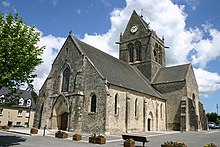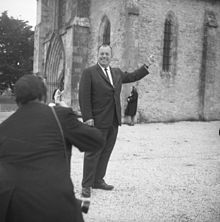John Steele (paratrooper)

US - paratrooper Private John M. Steele (* 29. November 1912 in Metropolis , † 16th May 1969 in Fayetteville ) of June 6, 1944 landed in the early morning during Operation Neptune involuntarily on the steeple of Sainte-Mere-Eglise . He became famous after this mishap was discussed in the Hollywood film The Longest Day .
Origin and family
John Marvin Steele was born on November 29, 1912 in Metropolis, Illinois . His mother was Josephine Lynn Steele and his father was Captain John Steele, who drove ships on the Mississippi. John Marvin was one of seven children of the Steeles. Three of the brothers served in World War II. One of the three, Norman "Short Dog" Steele, died just weeks before the armistice. Another brother, James "Oney" Steele, fought in the Marines in the South Pacific . There he was badly wounded and therefore spent a lot of time in the hospital .
F company
Steele served in F Company, 3rd Battalion, 505th Paratrooper Regiment, 82nd Airborne Division . He was a company senior, in 1944 he was 32 years old, and also the company barber . The rest of the company consisted mostly of volunteer soldiers who had not yet reached their twentieth year. He was described as very personable by his comrades.
He broke his leg during a first battle jump in Sicily. A second in the Naples region went without injuries. Steele then returned with his unit to Great Britain to take part in preparations for the Normandy landing.
What happened during Operation Neptune
The paratroopers of the 82nd Airborne Division were to build a bridgehead on the Merderet River and take and hold the intersection of Sainte-Merè-Église. To do this, they were dropped off west of Sainte-Merè-Église in the early morning of D-Day . In preparation, Allied bomber forces attacked targets throughout Normandy. Also in Sainte-Merè-Église, among others. A stray incendiary bomb set a building on fire, whereupon the residents of Sainte-Merè-Église, but also the German soldiers, were alerted by the ringing of the church bells of Sainte-Merè-Église. The residents formed buckets to put out the fire, but they did not succeed. The church square was well lit that morning and full of townspeople and German soldiers. At this time, the US paratroopers began to drop down and some landed in the center of Sainte-Merè-Église. They were under fire from a unit of the German 91st Airborne Division defending the site. The pull of the fire caused an American to land in the middle of the burning building.
John Steele jumped out with F Company that morning. His jump ended at a corner tower of the steeple of Sainte-Merè-Église. Trying to cut himself loose with his knife, his knife fell from his hand. A comrade, 17-year-old Ken Russell, also caught his parachute on the church. From there, they are said to have seen how their comrades, who got caught in trees, on houses or flagpoles, fell victims of German defensive fire. However, some statements about the intensity of the fighting in the church square are considered exaggerated. Russell later reported that Sergeant John Ray was shot in the stomach by a German soldier while trying to save her . When he fell to the ground, Ray shot the German, who had turned back to the two, in the back of the head and was able to save them for the time being. Raymond Paris, resident of Sainte-Merè-Église, also witnessed the events of that morning. He hadn't seen Steele hanging from the church tower over the church square. In fact, it hung on the north side of the tower facing away from the church square. According to him, the Germans shot at the planes and the Americans, who got caught in their umbrellas or got stuck in trees. They even shot at civilians who were trying to free them, but he said there was no slaughter as depicted in The Longest Day .
The paratroopers, who had landed outside of Sainte-Merè-Église and were able to gather, penetrated the town under the leadership of Major Edward C. Krause and forced the Germans to retreat. A German soldier in retreat spotted Steele at the church tower and shot him. Without knowing it, he only slightly wounded his foot. Steele then pretended to be dead and hung so a total of about two hours next to the roaring bells on the church tower. Another German became aware of Private Steele, who was playing dead. This hid the apparently dead. The German was looking for chocolate and cigarettes . So Steele got into German captivity and was taken to a hospital . He was deaf for weeks because of the ringing bells. He later escaped captivity and joined an American tank unit and then back to his ancestral unit.
The Germans launched a strong counterattack, but it failed. Units of the 505th held the place alone until June 7th, until armored troops from the north and infantry support from the south provided relief . Around noon on June 8th and after two days of German artillery bombardment, the city was finally liberated. Steele received the Bronze Star for his achievements and the Purple Heart for his wounds in battle . In total, Steele took part in six campaigns in theaters of war in Europe, Africa and the Middle East. This also included the Battle of the Bulge . He came up with four combat jumps (twice Italy, Normandy, Netherlands).
Sickness and death
John Steele died of complications from cancer in a hospital in Fayetteville, NC , on May 16, 1969, at the age of 56, three weeks before the 25th anniversary of the Allied landing in Normandy . He is buried in the Masonic Cemetery in Metropolis. He left his daughter Martha and many nieces and nephews.
Commemoration
Today in Sainte-Merè-Église many places commemorate the American air landing. So the Airborne Museum was founded opposite the church, in which many contemporary exhibits are on display. Weapons, badges and photos of the airborne operation were set up around a Douglas C-47 and a Waco cargo glider. You can also see original vehicles and guns, such as B. a GMC truck or a Sherman Firefly . In a hall of the museum you can also find airborne equipment and uniforms of the US armed forces from 1943 to 1950. Probably the most famous exhibit of the place hangs on the church tower. A doll in US paratrooper uniform hangs on a white parachute on the church tower above the church square. Steele actually hung on the north side of the tower, but for tourist reasons it was decided to hang the doll over the church square. White parachutes were not used at the time because of camouflage. These were olive green, but the white parachute stands out better from the masonry of the church. In the gabled house of the church, a window shows three paratroopers at the feet of the Mother of God . Bullet holes can still be found on the church today. A hotel in the village is named after John Steele, the Auberge John Steele . Here, too, the air landing is commemorated by many photos, letters and various other objects on the walls.
In addition to the commemoration, the tourist marketing of the sacrificial battle in Normandy takes place. Thousands of tourists, often descendants of the GIs who were fighting there at the time, come to Sainte-Mère-Église every year, and they represent a profitable business for souvenir and kitsch dealers. After Steele's death, a cheater of the same age pretended to be him and benefited from the gratitude of the residents of Sainte-Mère-Église on repeated visits. The dizziness was only revealed around 2009.
filming
In the war film The Longest Day (The Longest Day) from 1962 among others the events of June 6, 1944 in Sainte-Mere-Eglise are displayed. John Steele is portrayed by Red Buttons . Steel's comrade, Ken Russel, does not appear in the film. In addition, Steele is rescued from the tower by Americans. The film was based on the book The Longest Day. Normandy: Filmed June 6th 1944 ( The Longest Day , 1959) by Cornelius Ryan .
Web links
- The 505 Association: John M. Steele ; Articles on and letters from John Steele attached
- Press collection on the landing of the Allies in Normandy with statements by Raymond Paris (PDF, 89 kB)
- Blurred vision Text archive Berliner Zeitung, June 5, 2010
- The landing stern.de, June 9, 2004
- The Story of John Steele, the Sainte-Mère-Eglise Paratrooper normandyamericanheroes.com, March 16, 2017
literature
- Cornelius Ryan : The longest day , Bertelsmann, Gütersloh 1962. pp. 144–146, 173
- Kurt Kister : The longest day , in: Süddeutsche Zeitung from 15./16. June 2019, p. 55
- Jana Zimdars: Awareness of history and culture of history - facts and fictions in the war film "The Longest Day" , Grin Verlag, 2008, ISBN 978-3-640-14165-4
| personal data | |
|---|---|
| SURNAME | Steele, John |
| ALTERNATIVE NAMES | Steele, John M. |
| BRIEF DESCRIPTION | American paratrooper |
| DATE OF BIRTH | November 29, 1912 |
| PLACE OF BIRTH | Metropolis |
| DATE OF DEATH | May 16, 1969 |
| Place of death | Fayetteville |










